#Fence Line Foreground
Explore tagged Tumblr posts
Text








09.27.24 - Flashback Friday - Watercolor Class Memory. This one goes back to the summer after 3rd Year so 1990. In March of that Year Mom and I went on a 10 Day Spring Break Trip to Moscow, (at the time) Leningrad, and Vilnius that was organized through the International Studies Department. In the Fall I would be starting up 4th year doing the Study Abroad Semester in Europe. The Summer in between those two trips was my first time staying in Blacksburg through the summer taking classes. Summer School was a wonderful experience, one I repeated after my 4th and 5th years as an undergraduate and also after both years as a graduate student. That first summer of 1990 is when I took my one and only art/painting class. It was offered through the art department. The focus was on landscape painting and it helped me to get acquainted with more of what the area had to offer. It was also the Summer I discovered the joy of The Steppin' Out. That summer I also drove to Missouri to spend some time visiting with relatives, then on to Austin to visit with my Brother and some of his Air Force Friends, and then back to Blacksburg to see some friends who would be starting up the Fall semester in Blacksburg having either worked or been on the Summer version of the Study Abroad Program. The source painting was maybe at Smithfield Plantation. It was because of taking this class that I had my watercolor supplies to take with me on the Study Abroad to do some painting during that 4 month trip. Mom's sacrifices and financial management facilitated all of my best experiences growing up. Yay Yay Yay for Mom. I love you so very much and am extremely grateful for all of your ongoing love and support throughout my life.
0 notes
Text
a commissioned trivet!
one thing I’ve learned from this kind of sgraffito is to start with the foreground
here I start with the collar and chain, then the unicorn, before carving the fence. the shape of whatever is in the foreground should follow the lines of my sketch
(keep in mind it’s a little different if you’re carving away the space around your subject instead of the subject itself)
#sgraffito can be terribly complicated to explain lmao#I wish I were better at explaining#pottery#ceramics#ceramic#ceramic art#sgraffito#carving#timelapse#video#unicorn#unicorn tapestries#fantasy art#fantasy creature#commission
557 notes
·
View notes
Text
About the vol.19 inside cover.

If we go by the interpretation that the foliage and cityscape are background language for country mouse and city mouse in accordance to Kishibe's definition of normal/screws loose respectively...
Then Fumiko standing behind the plants vs Miri's superimposition over them in the foreground can read as both of them toeing the line between being "human" and a "tool" in their identities w Fumiko placing herself closer to the city in the background and Miri positioning himself w the plants in the foreground as he looks to the sunny sky.
And this is despite the perspective of the image presenting Fumiko as being closer to the plants and Miri further from them.
The plants acting as Miri's degree of separation from the city (the humanity he clings onto to distance himself from his devilhood) to bask in the sun so he can grow like them. Hopeful.
Fumiko's concealment by the plants pushes her into the back and the way they cover her legs almost make it seem as if she's falling off the edge (she even has her leg behind the dangerously low fence) the off-kilter way she's positioned as she lets herself fall, and she keeps her grin, facing the viewer to show that this is deliberate, this is what she chooses as her humanity.
As uncanny and grim as it appears under the dimmed sky.
23 notes
·
View notes
Text
Got the jujube in the ground! Cool contorted Chinese fruit tree with no native pests here, let's go! Got the roll of fencing free of the grass, too.

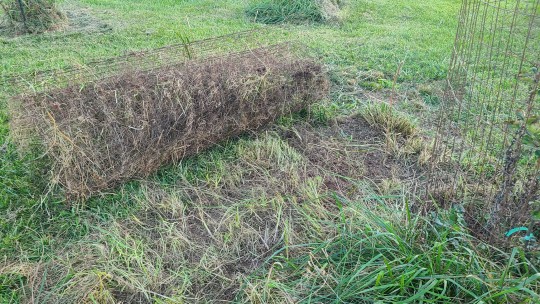
Not quickly, though.
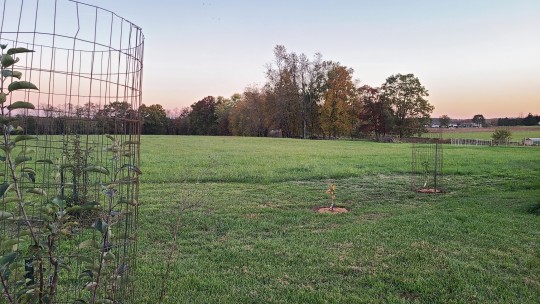

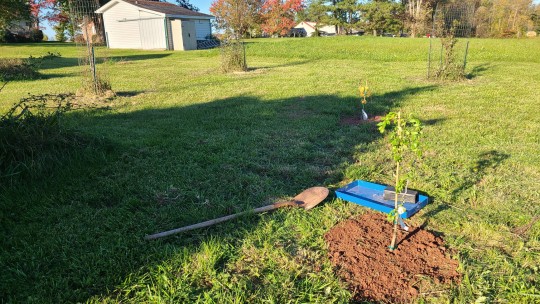
Several different angles of the orchard, which travels down the side of the chicken run and curls around the garden shed. In the next couple years, the trees will be too big for my little fence rings, and we'll need to find the money for a perimeter fence. Which keeps getting bigger as I add more trees.
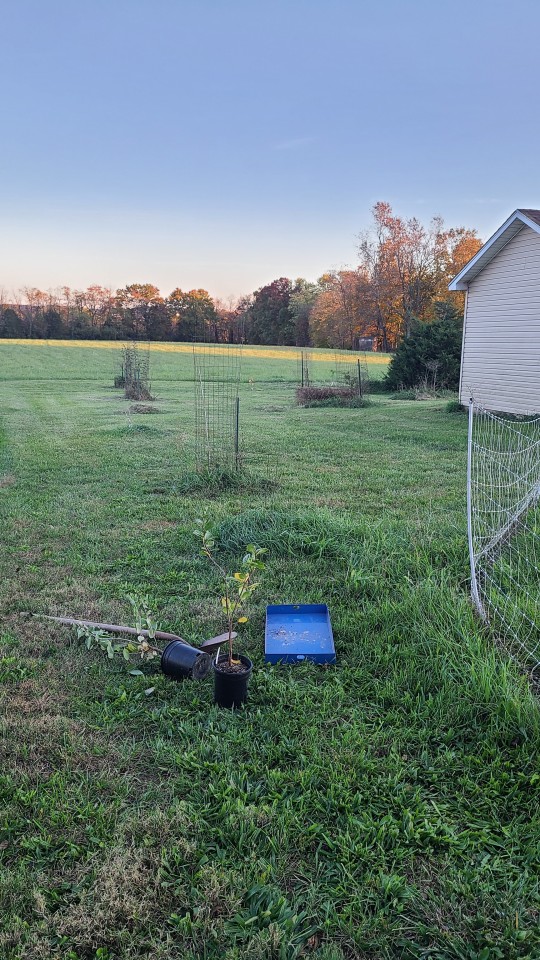
I'm facing away from the house here, in a little avenue of trees and shrubs, half on our property and half on the neighbor's. The two potted plants in the foreground are bush cherries that I hope to get planted tomorrow. You can see the chicken fence on the right. The trees and shrubs as you move down the line away from me here are two hazelnuts (they're there, I swear. The drought has taken them down to the ground twice in two years), a mulberry, a medlar, and two apples. To the right, and less visible, are two cherries, a plum, and the new persimmon and jujube.

And here's my heartnut tree, which also died to the ground and came back. And my chicken run in all its weedy glory.
There are trees and shrubs planted elsewhere, but this is the orchard as it stands. I still have at least one mulberry, a different apple tree, and my hardy orange to put in here.
13 notes
·
View notes
Text
Neopronouns in Action #090: Gaining a New Perspective
This is almost exactly 5k words long.
See this post for many places to experience Flatland: A Romance of Many Dimensions, for free!
How it started:

[ID: A digital drawing of characters from the book Flatland: A Romance of Many Dimensions. In the foreground is the narrator, a square who is orange, green and pink, with the pink forming a shape like a blobby fish with a single purple eye on its back. On each of his corners are small white triangle markings facing inward, helping to disguise his true eye, which faces upward as he falls. He is labeled, "Raymond, he/him/his/himself, 2D square", and "[Getting ejected from the Third Dimension for speculating about the existance of the Fourth and beyond". Above him in the distance is a pale red sphere with darker red and blue markings, still with one hand out stretched after throwing Raymond. The other arm ends around the elbow. Xet is labeled, "Kormance, xet/xev/xel/xevself, 3D sphere". End ID.]
Neopronouns: xet/xev/xel/xevself, which follow the same rules as he/him/his/himself.
Replace he with xet
Replace him with xev
Replace his with xel
Replace himself with xevself
EX:
"He is going to adopt a new puppy soon, as soon as he gets a fence set up around his yard so the puppy can go outside without him having to walk it. His uncle is going to help set up the fence, since he has a set of power tools he’s letting him use, since he lost his. He's going to buy toys and train the puppy himself.”
Becomes:
"Xet is going to adopt a new puppy soon, as soon as xet gets a fence set up around xel yard so the puppy can go outside without xev having to walk it. Xel uncle is going to help set up the fence, since he has a set of power tools he’s letting xev use, since xet lost xel. Xet's going to buy toys and train the puppy xevself.”
(Archived read-more link)
___
Beneath a vast ocean, looking down at a lower layer of density that swarmed with life, there floated a sphere. From above, xet was only deep blue and pale red, with darker red spots covered in small blue spots on the xel left and right sides. Lowering yourself down further, you could see xel back, which still had the same thick blue stripe, now with a multilayer of red diamonds in the center, with another red spot visible on xel lower surface.
If you swung around to look at xel face, you would see xel single, oval shaped eye, with a white sclera, and blue and black diamonds for the iris and pupil. Above the eye on either side were two dark red diamonds, and below blue circles, each connected to the eye with a thin line of the same color, like sections on a microhip.
Xel had a mouth filled with the sharp teeth of a carnivore. This mouth was currently twisted into a regretful frown, and the brow above the single eye furrowed in frustration and unease.
Xel had two arms, and only one hand. Xel right arm ended at slightly less the length of the left in an uneven stump. There were no signs of battlescars, because Kormance, the sphere, had been born this way.
Xet stared down towards Flatland, watching as Raymond, that impudent, foolish, insane Square, fell back down to where he’d come from, spinning like a coin as he went, turning almost invisible when his thin edges faced up towards Kormance for just a heartbeat at a time.
His outer edges glowed white, but his insides were mostly pink, with green and orange and white around the edges, with what seemed like a large, staring purple eye.
But it was all just one of Nature’s forms of defensive trickery. The pattern of pink surrounded by green, along with the eye that seemed to stare directly up at you when he was actually in his natural realm of Flatland, created an almost exact replica of a wexli – a small, but incredibly poisonous scavenging fish – as seen from above.
Scientists had studied and published their findings about Flatlanders for thousands of years, so xet knew that the clever mimicry had evolved ages ago to help fend off predation by many of the three-dimensional species who had once preyed upon them.
Now there were only a few highly specialized species that were still observed preying upon Flatland humans, but they were becoming rarer by the decade.
Raymond fell, spinning end over end, and Kormance couldn’t see his real eye, but xet wondered if he was looking up at xev, or down at his own world, approaching so rapidly. The only visible difference between his upper and bottom sides was a slight silvery sheen on his lower side.
Kormance shouldn’t have thrown him like that, but xet hadn’t been able to help xevself.
Raymond had started on his tirade of higher dimensions, and just kept going and going, getting more hysterical the longer he went, and nothing Kormance had said had gotten him to stop. He’d gotten to the point saying they were going to visit an eighth Dimension for Starlan’s sake, and Kormance was sure that xet would have lost xel own mind if xet had had to listen to that deranged Figure for even a few more seconds.
So xet had thrown him back down to his Plane.
Xet wasn’t proud of it, but at least xet knew that Raymond wouldn’t be harmed. The surface of Flatland was liquid, and they hadn’t been up so high that any damage would be caused. He might sink below the surface for a few moments with the impact, but after that he would naturally float back up to his natural placement in the density layers.
Kormance knew this from reports of the last Millenial Mission, when the Square Pyramid, Pathodorax, who had also brought her Envoy to the Third Dimension, had been forced to drop her back into Flatland in an attempt to save her while fleeing from a pack of selakhos that had ambushed them.
Selakhos never cared for Flatlanders as long as they were in their plane, but it was almost certain that the Flatlander would have died in an encounter in three Dimensions.
After dropping her Envoy, Pathodorax had found a cave to hide inside until the Recorders came and drove the selakhos away.
When Recorders had been dispatched to check up on her Envoy, they found the Kite emotionally upset, which was understandable, but physically uninjured.
The Recorders had listened in as she told her story to another Figure who had taken her in. She’d fallen, felt herself hit the layer of Flatland, and saw nothing but darkness for a few seconds, then reemerged in Flatland itself, several dozen miles from where she had started.
This is why Kormance had been careful to keep xel mission to a small radius just wide enough to allow a trip to the capital city, which was only an hour away from Wentbridge where Raymond lived, just in case that sort of disaster somehow happened.
Not that Kormance had had to worry about selakhos or any other predators, since the chosen areas over Flatland had been carefully monitored for the weeks leading up to the new year, ensuring that the movements of any dangerous animals were being tracked at all times. Kormance would know if anything had turned in xel direction long before it actually reached xev. The Recorders had been very careful to make sure nothing would go wrong this time.
They were very strict about maintaining the Millenial part of the Millenial Mission, for reasons Tormance could never understand. They were always going on about some prophecy they’d never actually tell anyone the details of. It was infuriating.
But nothing had gone wrong, at least not until the very end.
Long story short, Kormance had made sure to keep close to Raymond’s house after their visit to the Flatland capital, and even now, xet watched as Raymond, now tiny from the distance that yawned between them, splashed down with perfect aim inside his own studyroom, right side up.
Just as had been predicted, Raymond sank below the surface of Flatland for a moment or two, but then was buoyed back up almost immediately.
Kormance wondered what that had to feel like to a Flatlander, and felt guilt creep through xel insides. Xet really shouldn’t have thrown him like that. But they’d been running out of time anyways, and at least he was safely in his home again, and hadn’t landed Wrongsideup.
That would have forced Kormance to go back to put him Rightsideup. Xet could live with many things, but xet wouldn’t have been able to live with xevself if xet’d purposefully left a Flatlander flipped the wrong way like that.
That was another thing that had been Recorded during the last Millenial Mission. Not Pathodorax’s Envoy, but another’s – a Messenger whose name had been struck from the Historical Record for reasons not revealed to anyone but Recorders. The Flatlander had been taken into real space, and returned, but returned Wrongsideup. And by the time their Messenger had realized the mistake, the time was up, and they were prevented from returning to flip their Envoy Rightsideup again.
The Recorders of that era had been extremely interested in the monitoring of that Envoy’s life.
Only enough details of it had been released for public knowledge for Kormance, and every other Messenger, to know that being flipped Wrongsideup wasn’t something any of them wanted to subject their Envoy to.
Raymond’s landing must have made a noise, because as Kormance watched, the longer Straight Line that was Raymond’s wife rushed to the room he’d landed in, and for the next few minutes, the two seemed to be speaking, though from so high up, Kormance couldn’t actually hear what they were saying. All xet could see was the constant movement of their insides, indicating anxiety.
For a few seconds, xet considered going back down, to finish the lesson. Xet hadn’t gotten a chance to explain the makeup of all any Solids besides Cubes and Spheres. But it was too late now. His wife was in a very small room with him, and there’d be no way for Kormance to get to him again without her noticing.
And not only would Raymond probably not listen, he’d probably just go off again about higher dimensions, instead of listening and learning the rest he needed to know about the actual reality of the Third Dimension.
For a few more seconds, Kormance hesitated, struggling against all xel excuses, arguing with xevself.
And then xet sighed, and turned resolutely away.
Today’s Mission hadn’t been a complete failure. Xet had convinced xel Envoy that the Third Dimension did really exist, albeit through drastic measures. There were bound to be others today who had failed their mission, even if they’d also resorted to bringing their Envoys to the real world. Kormance couldn’t afford to dwell on the negatives, xet had to think positively. Xet had succeeded. Raymond fully believed in the Third Dimension.
It wasn’t Kormance’s fault that Raymond had gone insane once his mind was opened to the possibility of another Dimension. Kormance had tried to stop him from jabbering on about the analogy and infinite dimensions, but nothing had worked.
Kormance was trying to stay positive, but it wasn’t working well, xet was too anxious and angry. That absurd little fool had repeatedly asked xev to show him xel insides, like xet was a shape as simple and open as a 2D Figure or lower, like xet could somehow just will xel internal organs into view for the sake of a rambling Flatlander.
Who did he think he was? He hadn’t even known the word “up” before Kormance had taught him, hadn’t had any idea there was a Third Dimension! And then he had the gall to turn around and ask to be shown the fourth! And the fifth! And the sixth! And who knows how long he would have gone on if Kormance hadn’t thrown him back where he belonged! Like he expected Kormance to somehow be able to perform miracles! It wasn’t fair! It wasn’t Kormance’s fault!
But xet had to admit now that it was clear that Raymond had been a bad choice for an Envoy of the Third Dimension. His mind had clearly been stretched beyond its limit, and now he couldn’t recognize the limitations of reality anymore.
Kormance had chosen him almost on the spur of the moment, aggravated by his arrogance towards his own grandson, who despite being so young, clearly knew more than he did.
Originally, Kormance had been planning to teach the child, since young minds were always more willing and able to learn new things, but other considerations, xel pride being the major contributing factors, had gotten in the way of that plan, and now look what had happened.
But maybe it had been inevitable. The hexagonal child had done the exact same thing his grandfather had done, after all. He’d been shown the existence of two dimensions, and said he was ready to learn about the third. And then his grandfather had been shown the existence of three dimensions, and said he was ready to learn about the fourth. Both had looked at the reality that had been revealed to them, and tried to follow the pattern even further.
It was admirable, really.
...And the longer Kormance thought about it, the more and more xel thoughts seemed to all crowd together, different thoughts and feelings conflicting with one another as xet floated on xel back, looking up at the sky, the stars of which were covered in thin white wisps of clouds here and there, with the green and white face of the moon wavering just over the edge of the horizon.
There were only Three Dimensions, and no more.
Science had proven this, and so did every day of Kormance’s experience.
Raymond had tried to convince xev that the ghost hunters and self-proclaimed psychics of xel world had actually had contact with the “fourth dimension”, just like he, the Square, had been visited by Kormance the Sphere. But that just couldn’t be true.
And yet, that little hexagonal child had been right when he’d said that it was clear that even their Flatland geometry lead them to the next logical step of a third dimension. And Kormance had been happy to see a Flatlander, especially one so young, figure this out all on their own.
But then, when that child’s grandfather came to the same conclusion when he saw proof of the third, leading inexorably to the fourth…
But Kormance and the others who had been chosen to carry out the Millenial Mission had always had the clear goal of instructing Flatlanders about the existence of real space. They told them flat out that there were more than two dimensions. They never lied or pretend to be spirits, or at least, they hadn’t done that for the last two thousand years. The Recorders had made sure of that.
So that meant that if what Raymond had said were true, and Beings were coming down from the so-called fourth Dimension, then why wouldn’t they just say that that’s where they were from?
None of the people who’d ever claimed to be able to see inside things or leave the world had ever claimed they were going to the Fourth Dimension when they did so. They didn’t even say they were going to the real Space. So either the hypothetical Fourth Dimensional beings were lying, or their Envoys were.
And what reason could they have to lie about such a thing?
Most of their countries in Spaceland were more civilized than those in Flatland; they didn’t execute people just for talking about things they didn’t want to hear. No one would be murdered or thrown into life imprisonment if they went around telling everyone there was a fourth Dimension, not if they had proof.
...But would they have proof?
Kormance turned to look down again, back towards Flatland. Xet had drifted slightly while xet floated, and now xet was above the large, and now almost empty theater, rather than directly above Raymond’s home.
Xet stared down, watching the oblivious Figures in the back of the theater as a few Isosceles triangles were busily working to store away all of the equipment for the play and clean up the trash that had been left behind by the patrons.
None of them knew xet was up here, or that they were being watched.
They had no concept of up or down, and couldn’t move in either direction even if they tried. Even knowing about the Third Dimension wouldn’t give them any more ability to move in it. Not without help from a Third Dimensional Being.
Kormance knew that it was almost impossible for a Flatlander to prove to other Flatlanders the existance of the Third Dimension on their own, without the assistance of a Three-Dimensional Being.
They couldn’t lift themselves into real 3D space, or lower themselves into it. They couldn’t demonstrate in any way the directions of up or down, or even describe which way they were. They couldn’t point up or down, they couldn’t even look up or down.
The only thing they had was their word, and their imaginations. Their only hope was to fire the imaginations of those who let them speak, and there were very few in this region of Flatland who would let them speak.
Who would believe Raymond if he did tell anyone what had happened to him, and what he had seen?
Kormance knew that it was only a matter of time before the Circles passed their law once again demanding the arrest or execution of anyone found to be preaching the truth of the Third Dimension. If Raymond ever revealed the truth, no one would believe him, and he would be risking his life in doing so, no matter how comparatively high his personal status was.
And for what?
Not for the first time, Kormance wondered why the Recorders insisted upon these Millenial Missions. Why the Messengers were limited only to teaching a single Flatlander each, once every thousand years, knowing that most of the Flatlanders they revealed the truth to would be powerless to teach others, if they were even allowed to live at all.
For just a few minutes, Kormance had thought about recruiting the hexagonal child to the cause. As a Hexagon who was part of the noble caste, he would have had more protection from the punishments of the Circles when he was found out.
But a Square was still high ranking enough that it wouldn’t mean instant death, especially for a Square of such unusually high social standing as Raymond.
He was extremely educated in the fields of Flatland mathematics, to the point where he was regularly invited to high-profile clubs attended otherwise almost entirely by the nobility. He was well-trained in the art of Sight Recognition for someone of such “poor Configuration”, and had, as far as his society was concerned, single-handedly raised his hexagonal grandsons after the death of their father, before his remaining adult sons had moved back in with him the week before to help fill out the extravagant house their eldest brother had bought before his, and his wife’s, untimely deaths.
(The fact that Jemima, Raymond’s wife, who was a Straight Line, and his daughter, Lorraine, also a Straight Line, had done all of the work of actually caring for and raising the young Hexagons was not acknowledged at all. They received no credit for their work, because the Flatland Configurationists insisted that Straight Lines or “women” were just inherently natural caretakers of children, going so far as to say that that’s all they were good for, so there was no point in praising them for it, because then you may as well praise gravity for pulling southward. [This all despite the fact that most Flatlanders could get pregnant and bear children, not just Straight Lines.]
So all of the credit for the two Straight Lines’ three years of unexpected work nurturing and raising the two young Hexagons that had suddenly been dropped into their laps after the family’s tragedy went instead to Raymond, the Patriarch of the household, who’d had next to nothing to do with the children until a few days ago, when he’d started teaching them the basics of Sight Recognition.)
Add to this the fact that Raymond had fathered so many healthy, completely “Regular” sons in the first place, with only a single daughter in a total of seven births, and her Configuration comendably just as Straight as any Straight Line could be, and it was hardly any wonder that the women-hating, Configurationist nobility regarded Raymond as a Square almost beyond his own class?
Kormance had little to fear that Raymond would be killed if or when he revealed his knowledge of the Third Dimension to his countryfolk. He was too highly esteemed, too accomplished for that.
The nobility knew how rare it was to find Squares who genuinely, consistently produced Regular Pentagonal offspring. They wouldn’t risk killing him, not unless he did something drastic beyond imagining that would actually merit killing him and anyone he’d ever spoken to.
But that was doubtful. He would most likely be kept alive, either in prison, or an asylum. Kormance was sure that something would be arranged so that Raymond and his wife would have the opportunity to produce more Perfectly Regular Pentagons for the ruling classes to hold up as shining examples of their cherished “Law” of Natural Progression.
The Configurationists valued their eugenics programs too much to waste an opportunity like that. They’d probably even furnish Jemima with a pension of some sort, maybe a chapperone, to make sure the house was maintained and the new children kept well fed and cared for. Or maybe they’d just adopt the children out into families of real nobility. There was no way to really tell.
Kormance didn’t know for sure what would happen to the rest of Raymond’s family if or when he was arrested. Only one of his sons had had his own sons so far, the rest were still bachelors. It was too soon to tell if his “Progressive Regularity” had been passed down or not. So maybe the Configurationists wouldn’t touch them until they saw whether or not they’d be useful for their long-term plans.
Most likely it would depend on how publicly and successfully he attempted to preach his heretical gospel of the Third Dimension. Or maybe it would never happen.
Not all the Flatlanders ever chosen to be given the knowledge of the Third Dimension had revealed that knowledge to others. Some of them carried the secret to their grave.
Kormance didn’t even know what the point was in telling them, not when everyone who cared enough to know knew that in 10% of Flatland, talking about the Third Dimension, or anything related to it, including talking about where light came from, meant either instant death or lifetime imprisonment.
The Recorders knew this. So did the Shepherds. So did all of those chosen to carry out the Millenial Mission. For Starlan’s sake, most of the general population knew it too!
They knew that by sending missionaries to spread the knowledge of the Third Dimension, they were condemning 10% of those chosen to learn it to death, imprisonment, or a lifetime of having to keep the truth of the world secret, tormented by the paranoia of anyone finding out what they knew.
And maybe 10% sounded low on paper, when you were just thinking of the millions of Flatlanders as abstract concepts, but they were real people. 10 out of every hundred Flatlanders who were chosen would live in areas where sharing their knowledge would mean severe punishment from their governments, and this only included the countries where it was on the books illegal, it didn’t include any of the places where it wasn’t outright illegal, but could still mean death or imprisonment anyway.
It was cruel, and unnecessary. It couldn’t be done in good conscience.
But that was why Kormance and the others were doing it, instead of the Recorders or Shepherds, or anyone else, wasn’t it? They were convicts, felons, prisoners. As far as everyone else was concerned, they’d already committed crimes, so what was one more moral weight upon their cores?
They had neither the right to freedom, nor to conscience.
Well, no, that wasn’t entirely true. Some of them had a conscience. Some of them refused to reveal the real shape of the world to the Flatlanders, knowing that their Envoys might be killed for what they’d taught them. Two of the other prisoners assigned to the same region as Kormance had been conscientious objectors. They’d been dropped down with Kormance, been given the same orders as xev. But instead of heading off to find a suitable Envoy, they’d crossed their arms and sat in place, completely refusing to take part.
When the Recorders came to collect them all, they would be thrown back into prison, just the same as they’d been taken out.
Kormance wished xet could have been so heroic, but...xet just couldn’t. Xet didn’t want to spend the rest of xel life in prison, staring at the same four walls until xet died, and this was xel only chance to get out any time in the next ten years.
Xel family was still out there somewhere, wondering where xet had disappeared to or whether xet was still alive.
Xet had tried to choose xel Envoy carefully, wanting to ensure the least amount of danger along with the highest chance of comprehension, because xet couldn’t win xel freedom by failing to teach xel Envoy. It had to be a successful lesson.
So, a mathematician with high social status had probably been the best choice. He probably wouldn’t be killed, even if he did reveal the truth of the Third Dimension.
Kormance kept telling xevself that, but it wasn’t actually making xev feel any better. How many people had been killed today as the price for xel freedom? How many had died to pay for the freedom of the others who were probably out there still, in the further reaches of the 10% of Flatland that had made understanding the world a crime punishable by death?
All of those Isosceles in the council chambers, at least.
Each of them had had a name, friends, family, hopes and dreams for the future. And now they were dead, because Kormance had chosen to follow the orders xet had been given.
And who knew how many more would die in the future if Raymond chose to reveal his secrets? The secrets he only knew because Kormance had told him.
How many would survive, but would spend the rest of their lives in prison?
It had already happened to Raymond’s brother.
All of those deaths were on xel head. All of those people thrown in prison for the rest of their lives were on xel head.
The price of Kormance’s freedom had been high, and until the Recorders came to collect xev and the others, there wouldn’t even be any telling if xet had even won xel freedom at all.
The Recorders could still look at Raymond’s hysteria for impossible, even higher dimensions, and decide that Kormance had failed after all.
All those deaths, all those lives ruined, Kormance’s betrayal of xel own moral code, and it might all just be for nothing after all.
Xel eye was no longer focused anymore on what was below xev, Kormance was simply floating along with the gentle current, too lost in thought to focus on the life of the Flatlanders playing out below xev.
What if Raymond had spoken the truth? What if there was a fourth Dimension, or even more than that? He’s insisted it was all strictly according to analogy, just like with the Third Dimension…
A point moving created a line.
A line moving created a square.
A square moving created a cube.
The denizens of Lineland could not see a line unless they were taken into the Second Dimension.
The denizens of Flatland could not see a square until they were taken into the Third Dimension.
None of them had any idea anything else existed outside of what they could see until they were shown a new perspective.
And it...was a mathematical progression. All strictly according to analogy.
If a fourth Dimension really existed, then it would be beyond Kormance’s ability to perceive unless xet was brought into that Dimension by a fourth Dimensional Being, just as it was impossible for a Flatlander to perceive the Third Dimension, or a Linelander the Second.
And who even knew what kind of creatures lived in the First?
A deep voice spoke suddenly, saying something unintelligible to Kormance.
It jolted xev out of xel thoughts and made xev jump upright. There was nothing in front of xev, so xet spun around, surprised and confused. The Recorders weren’t due back so soon.
There was a sphere floating there, with their back xev. They were deep blue, covered in pale gold, five-pointed stars. Xet couldn’t see any arms at all, and felt a swell of befuzzled camaraderie bubble up in xel core. It wasn’t often xet got to meet other amputees. Who was this person? And what had they just said?
“I’m sorry,” xet said, circling around the stranger so xet could see their face when they spoke, “I couldn’t hear what you said.”
Xet circled to the other side of the sphere, but still couldn’t see their face. They’d turned as xet walked to keep their back to xev. Xet stopped, bewildered. Why would they do such a thing?
“Will you let me see your face?” Xet asked, feeling hurt, “It’s easier for me to understand what you say if I can see your mouth.”
There were a few moments of no response, then the deep voice spoke again, more clearly than the first time, “Sorry, but you won’t be able to see my mouth unless you come into the Fourth Dimension.”
Kormance could only stare.
The voice continued, after a few moments, “What you’re looking at is just a cross section of me, not my whole body. In the Third Dimension, I appear to you as only a sphere, the same way your Flatlander friend appeared as a point in Lineland, and how you appeared as a Circle in Flatland, but I am really a vwindir – or, an extra-sphere, as your student from Flatland so aptly called me. You really shouldn’t have dismissed him so quickly about the exter dimensions, you know. He may have gotten a little carried away, but he wasn’t wrong.”
There was a short pause, then the voice added, “But I digress. What I said first was, are you ready to visit the Fourth Dimension now? And, are you? I’ll be happy to answer any questions you have.”
Kormance’s first reaction was that this had to be some sort of joke. Someone playing a trick on xev. But then xet remembered that that was exactly how Raymond had reacted to xev, and how the King of Lineland had reacted to Raymond…
And…
Oh Starlan, this was actually happening, wasn’t it?

[ID: A digital drawing of two characters based on the book Flatland: A Romance of Many Dimensions, drawn against a grey-blue background. In the foreground is a royal blue circle covered with pale yellow stars, labeled, "Ted, they/them/their/themself, 4D vwindir", and "[patiently waiting for a reply]". They have no limbs or facial features visible. Behind them is a pale red sphere with a single eye and two arms, one of which ends around the elbow, with darker red and blue markings, labeled "Kormance, xet/xev/xel/xevself, 3D Sphere", and "[conception of the world being hastily rewired]". Kormance is staring at Ted with xel diamond-shaped pupil dilated, and a blank expression of shock and consternation. End ID.]
A million thoughts were racing through Kormance’s mind, but of all of them, there was one important question xet felt the need to ask, just to be safe:
“You promise you won’t put me back Wrongsideup?” Xet did’t even want to know how that would work for a Three Dimensional being, but xet assumed xet would be finding out shortl.
The voice replied, kindly, “I promise not to put you back Wrongsidelot.”
Kormance wondered if xet was dreaming, but xet didn’t think xet was.
“Well,” xet said, bracing xevself, “I guess I’m ready when you are.”
#described art#neopronouns#neopronouns in action#short story#short stories#original fiction#fiction#writing prompts#story ideas#public domain#neopronoun short story#Flatland#Flatland a Romance of Many Dimensions#4d#xet/xev/xel/xevself#xetxevpronouns#xet/xev#novapronouns#The Sphere#Flatland stories#Kormance the Sphere#described images
16 notes
·
View notes
Video
where in the world 491, volcanic history, new zealand by KeefH Hellinger Via Flickr: shot by KHWD want to see more images or read the blog www.holiday2007-8.co.uk/NEWZEALAND Photographing New Zealand’s rolling volcanic hills is a dream for landscape photographers. These undulating terrains, shaped by ancient eruptions, offer a mix of soft contours and dramatic geological features. Here’s how to capture them at their best: Best Locations - Waikato & Taranaki – Known for lush green hills formed by volcanic activity. - Rotorua & Taupō – Offers geothermal landscapes with rolling terrain. - Banks Peninsula – A mix of volcanic hills and coastal scenery. Ideal Camera Settings - Wide-angle lens (16-35mm) – Captures the vastness of the landscape. - Aperture (f/8 - f/11) – Ensures sharpness across the scene. - ISO (100-400) – Keeps noise low while adjusting for light conditions. - Polarizing filter – Enhances contrast and reduces glare. Best Time to Shoot - Golden Hour (sunrise & sunset) – Soft light enhances the contours. - Overcast Days – Creates moody, diffused lighting. - After Rain – Vibrant greens pop against volcanic soil. Photographing New Zealand’s rolling volcanic hills is a dream for landscape photographers. These undulating terrains, shaped by ancient eruptions, offer a mix of soft contours and dramatic geological features. Here’s how to capture them at their best: Best Locations - Waikato & Taranaki – Known for lush green hills formed by volcanic activity. - Rotorua & Taupō – Offers geothermal landscapes with rolling terrain. - Banks Peninsula – A mix of volcanic hills and coastal scenery. Ideal Camera Settings - Wide-angle lens (16-35mm) – Captures the vastness of the landscape. - Aperture (f/8 - f/11) – Ensures sharpness across the scene. - ISO (100-400) – Keeps noise low while adjusting for light conditions. - Polarizing filter – Enhances contrast and reduces glare. Best Time to Shoot - Golden Hour (sunrise & sunset) – Soft light enhances the contours. - Overcast Days – Creates moody, diffused lighting. - After Rain – Vibrant greens pop against volcanic soil. Composition Tips - Leading Lines – Use winding roads or ridges to guide the eye. - Foreground Interest – Include trees, fences, or livestock for depth. - Layering – Capture multiple hill layers to add dimension. For more inspiration, check out this photography guide www.wisemove.co.nz/post/new-zealand-lens-photographers-la... or explore stunning images of New Zealand’s rolling hills here www.alamy.com/new-zealand-rolling-hills-image210479136.html. Have you photographed landscapes like these before? I have and loved it, been back to NZ 3 times now and would love to go again, Best Kx see more in my doubles album, the same images in both COLOUR & B&W / Monochrome www.flickr.com/photos/keefhwebdesigns/albums/721777203247...
#KeefHWebDesigns#KHWD#Top Design Ideas via Pix#travel#travel photography#motorhome travel pix#motorhomes#need more faves#fave#KHWD geo location for KeefHWebDesigns#flickr
2 notes
·
View notes
Text
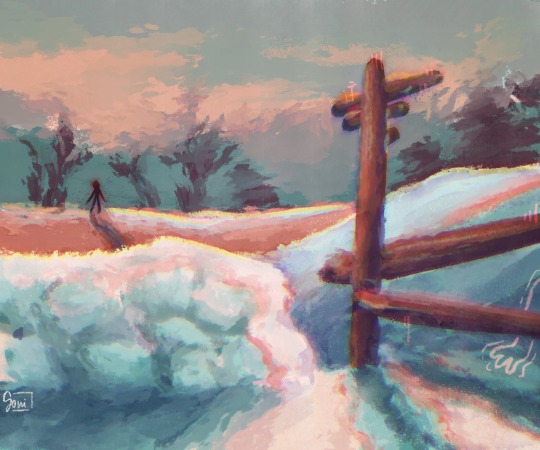

snowbank blues
[ID: Two digital paintings. The first pictures a snowy winter scene, with a blue and white wall of snow in the foreground. A broken fence sits next to the snowbank, with the outline of a hand below it, as if there’s a person sitting next to it outside of frame. The background is of a dark forest with pink grass, and pink clouds behind it. The dark silhouette of a person entering the forest is painted in front of it. The second image is a painting of a person from the shoulders up wearing a neon yellow jacket with pink and blue wavy lines behind them. The person is stylized in a color scheme with blue skin, purple hair, and glasses. A yellow silhouette is behind them, with red and sea blue lines around it. Wind gusts and snow are drawn in the background. /End ID.]
#my art#snow#snowbank blues#been listening to this song a lot lately#procreate#digital art#digital painting#snow art#snow landscape#return of the sad vibes yellow jacket
11 notes
·
View notes
Text
A Grand Day Out at Quarry Lakes
Sunday, 21 July 2024
Originally I was planning on doing this ride yesterday. But as I ran some errands first thing I felt the day was getting too warm for me to go for a fun ride. It has been a VERY long time since I went for a fun ride and I didn't want to overdo it. So, I left home at about 7:30 in the morning to get an early train.

Image Description: A light blue Retrospec Beaumont Rev-2 ebike on a commuter train platform.
But since this was a Sunday, trains don't run as often. While I was on time for the first train, I had a half-hour wait at my transfer station. Fortunately, I had brought a library book with me for just such a situation. The book in question was Queer Ducks (and Other Animals): The Natural Wold of Animal Sexuality by Eliot Schrefer.
After arriving at the Union City BART station, it was a short ride to a grocery store to get some supplies. Since I was so burdened with other things I needed to get yesterday, I didn't get food for the ride. So, I stopped at the store for some Gatorade, Clif Bars, and sunblock. From there, it was a short ride to Quarry Lakes Regional Recreation Area.

Image Description: A beige concrete sign with green letters reads, "Quarry Lakes Regional Recreation Area, East Bay Regional Park District." There are low plants around the sign and some trees behind it.
I have to admit, I stopped quite often early in the ride just to marvel at the scenery.

Image Description: The ebike from earlier on the path around one of the lakes.
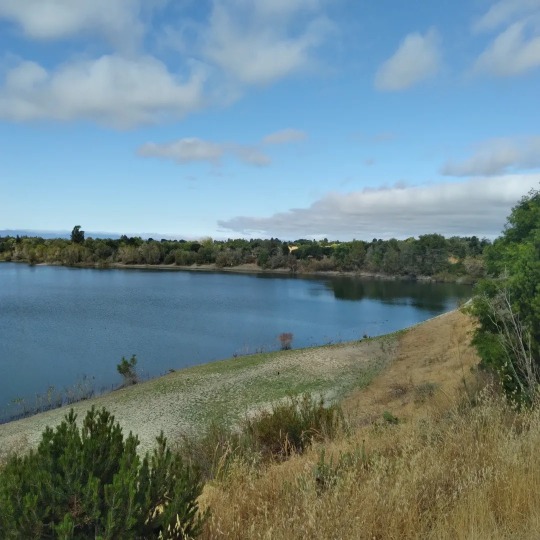
Image Description: Another view of the lake from above, with some crows on the lakeshore in the middle distance. Trees can be seen to the right and along the far shore.
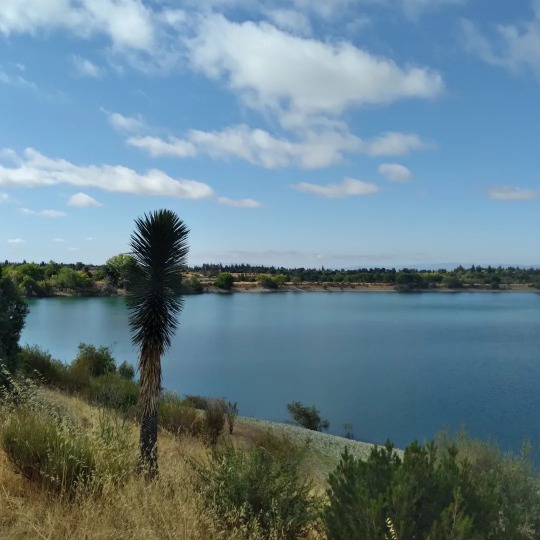
Image Description: Another view of the lake, with a single tree and some shrubs in the foreground and the tree-lined far shore.
As I kept going long the path, I eventually came to a small stand which had a map and brochure about this place. That's when I learned class-2 ebikes, like the one I was riding, are restricted to paved trails. Oops. There isn't a paved trail around the lakes. It's a gravel trail.
But the brochure's map showed where a paved trail was nearby. So I left the recreation area and headed for that trail.

Image Description: A concrete and stone cairn with a sign for the Niles Community Park.
The search for the paved trail led me past Niles Community Park, a place I visited some time ago with my motorscooter before it was stolen. I had to keep following the gravel path out to the street and over a bridge to get to the paved path. So for next time, I'll stay on that street, skip entering Quarry Lakes, and continue on to this paved path.

Image Description: A heard of goats lounging on the south shore of Alameda Creek.
And as I rode on that paved path, I past a heard of goats which seemed have been brought in to keep the vegetation in check along Alameda Creek. There was a temporary fence around a large area and there were just so many goats.
From there, it was ride back to BART, take BART toward home, and stop at another grocery store to finish getting the things I couldn't haul home yesterday.
By the time all the riding was done, my legs felt rubbery. I don't have the speedometer / odometer installed on my bike yet, so I don't know the overall distance I rode. I could probably try to work it out, but I'm not going to stress over it.
This was my first fun ride in a long time. I just haven't been strong enough to use my regular bike, so getting this ebike made things a lot easier. But as it's a class 2, I'll have to be more mindful of which East Bay Park Districts I visit with it.
I'm looking forward to more rides, and am already planning how to visit Quarry Lakes next time. I won't be able to ride around the lakes themselves, but there are parts of that park I can visit.
5 notes
·
View notes
Text
Week 8 - Artist Research
Christopher McKenney
Pennsylvania-born photographer Christopher McKenney specialises in surreal photography. His artworks feature dream-like environments with an ethereal feeling. Below, selected a few images that I liked the most.

The composition of this image has an overall snowy background with low saturation and brightly colourfully, bunched balloons, which are relatively higher in saturation. This difference in saturation levels creates a visually interesting contrast, alongside the colours. The image also appears to have very even lighting, and nothing is placed over another. The tree and dried grass in the background lead off into the distance, creating leading lines that lead to the rope holding the balloons. The balloons placed in the centre are the focal point of the entire image. In the foreground/background, you can see faint footsteps in the snow also leading off into the image. Although the overall image is relatively simple, the focal point, leading lines and colours drew my attention. I am curious about how he accomplished this image, as the balloons look fake in a way. Was there someone holding the balloons, and did he edit them out? Did he take an image of the balloons separately and edit it into the background?

This image caught my attention as I was trying to decipher how he had created it. The composition of the image has the main subject appearing to come out of a golden frame in the centre of the image. The background and foreground are blurred with dried scattered leaves, to further draw the attention of the audience's eyes to the focal point. The figure emerging from the frame is covered in an off-white sheet of fabric; the bottom of it is missing. The overall image also has a low saturation, which had also drawn my attention, as everything was very evenly lit and coloured. I wondered how McKenney could manipulate this image where people holding the frame as another person was inside, and then remove them in post-production?

The visually bright fire captured my attention. The overall composition of this image has a man standing in the centre of the photo with a cardboard box over his head, lit on fire, holding what appears to be a book. Behind him was a large fence and a partial view of a house. In the foreground, he appears to be standing on dry grass. The overall image has relatively normal saturation except for the highly saturated fire, creating a sense of juxtaposition, alongside with overly cool-toned image and the warm tone of the fire. This contrast makes the box on fire the focal point of the image, where eventually the eyes will focus further around the image, noticing the man where the box is placed. I question if this is all one image and he had placed a lit firebox on someone's head, or a compilation of several images made into one.
0 notes
Text

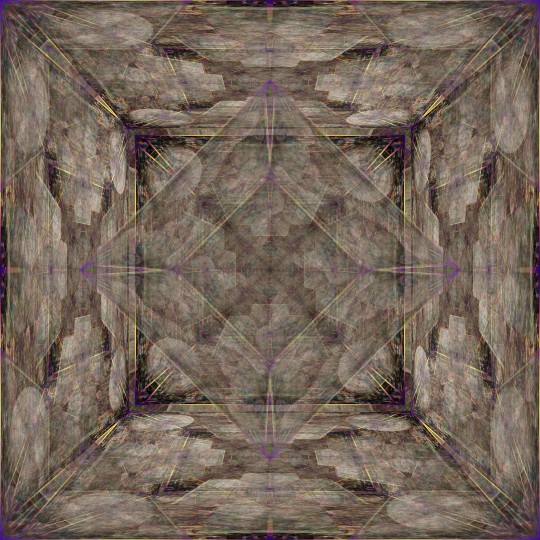


03.22.25 Fence Line Louvre Foreground
0 notes
Text
How to Create Depth and Distance in Landscape Art
Do you want to master the secrets of scenery painting? Do you want to make your scenic paintings come real with perspective and atmospheric elements? Just hang on there.
Whether you are painting austere mountains or serene valleys, one of the greatest challenges in landscape painting artwork is how you create the illusion of depth and distance. A flat perspective painting can feel lifeless, no matter how beautiful the subject. But when you add depth and drama to the work, your scenery artwork will rope the viewers in – and welcome them in the world of your fantastic landscape scenes.
In this blog, we will go through some useful techniques and timeless tips that help artists build visual layers and natural depth into their scenic paintings. No matter if you are working in oils, acrylics, watercolor, or digital mediums, these tools will help you elevate your scenery art painting from two-dimensional to ethereal.

1. To Know the Principle of Atmospheric Perspective
Aerial perspective is crucial for landscape painting, as this top view helps to see the objects in true light as they recede into the distance. As things move farther away:
They appear lighter in value.
They become less warm in terms of color.
They lose detail and contrast.
When you are doing a mountain scene, you can draw the textures of the closest peak with rich and warm earthy tones. While the farthest peaks look faded with soft blues or purples, mirroring the sky. This subtle color shift will make your landscape painting artwork feel realistic.
Tip: Try to keep the background ‘breathe’ with softer hues while keeping your darkest darks and sharpest edges in the foreground.
2. Use Overlapping Elements
With overlapping the artist tries to add relative space in a scene. Keeping one object partially in front of another will instantly place itself closer to the viewer.
They can be of -
A scenery of a tree overlapping distant hills
Rocks layered over a winding river
A fence partially hiding a field of wildflowers
This method works wonders in scenery art painting and tells a story about the composition.
Tip: Change the scale and order of the placement of object overlaps. Put large, detailed objects up front with smaller, faded ones in back to create a sense of depth.
3. Modifying Size and Scale
Use the basic rule of perspective in your scenic paintings to move less significant objects into the distance—diminishing the size of people, trees, animals, and structures in size as they move away.
Bonus effect: If aesthetically done, the scaling down of elements can give the small canvas a grand sense of space.
4. Control Your Edges and Detail
Another way of adding depth is to modify the edge of the objects of portrayal. Objects that are closer to the viewer will have sharper, more defined edges. Distant objects will appear more blurred or have softer edges.
Detailing can be done accordingly – accuracy diminishes as you move toward the horizon. Just a suggestion of a whole object plays the trick here.
This actually saves some time and makes your scenic painting more realistic.
5. Layer Your Colors Carefully
Layering is the key to depth and drama. Think of the three basic components like -
Foreground: use warm and bold hues with strong detail
Middle ground: use a notch less warm and softer tones
Background: use pale, cool hues that fade into the sky
Now, the trick is to blend the three players artistically that helps guide the viewer’s eye and creates a unique storytelling within your scenery artwork.
Tip: While you paint a sky, keep the gradient of color from the horizon warmer to the top as a cooler one. This subtle shift can hold the rest of your landscape.
6. Use Linear Perspective
Sometimes you need to add a linear perspective to your drawing – when you are composing a scenery art painting that has roads, rivers, fences, or architectural elements.
Use of vanishing points and horizon lines adds structure to your work. You can plan a light perspective perfectly while drawing a winding trail through a forest.
Plus: Create Depth with Composition Tricks
Leading lines like rivers, roads, or tree rows will take in more pair of eyes
Framing elements like branches, arches, or rock formations make the composition look natural
Contrast between shadow and light adds dynamic effect
The compositional tools play an essential role for artists. So, when you attend call for entries art contests or juried shows organized by modern art platforms like Gallery4%, think of these minute things that make your design great from good.
Final Thoughts: Deep Landscape Art
It’s not just technical perfection to create depth and distance in a landscape painting artwork. It’s all about crafting a credible world that feels alive. Blend perspective, thoughtful color use, and composition, and you can have your scenic paintings launched to the next level.
No wonder, it will help you boost your artist portfolio or to get selected in a call for entries art opportunity. Follow these techniques to make your scenery artwork stand out from clutter with a blend of movement and mastery.
No stopping then—start with your next landscape and paint not just what you see, but what you feel. Let the horizon inspire your strokes.
#scenery art painting#scenery artwork#call for entries art#scenic paintings#landscape painting artwork
0 notes
Text
Final Outcome part two: Addition of first layers of paint, Foreground.
Starting early on Saturday morning, I planned on doing as much as I can on the Weekend before London and other Holidays Im away on with family. On Saturday morning I began adding paint.
Starting off with the foreground of the pavement I used light grey, white and green paint mixed together to make an earthly version of the concrete that reflects the source image and develops from my other Landscape paintings inspired by Michael Spence.
once satisfied I moved onto adding the Yellow, using Fluorescent yellow paint I added Bus Stop markings, and the yellow brickwork of a nearby wall and the cobles that separate the pavement from the start of a bridge to the right. I also wanted to use the yellow as the make the composition as vibrant as possible while sticking the source material.
Using the green from the pavement I also added grass in the foreground and middle ground.
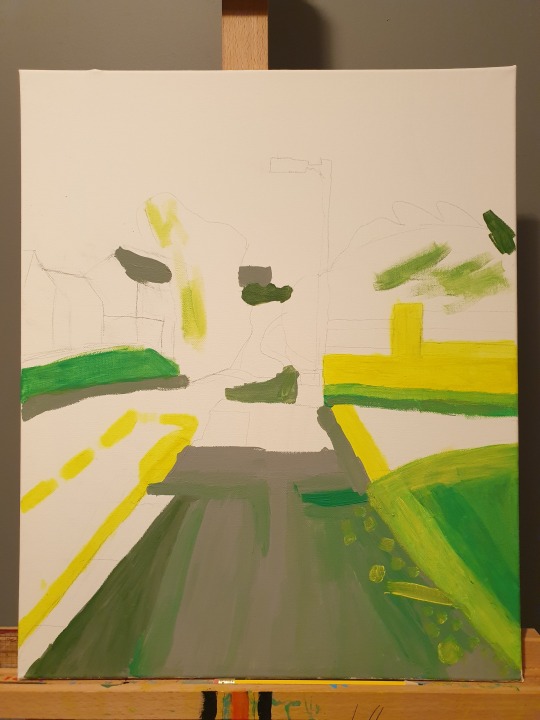

After hours of adding layers of paint until satisfied with the colours. I moved onto adding the blue of the wet road, and the trees on the left. this tree would be an abstracted representation of a line of trees. with s light green as a base and darker greens to add detail, depth and shadow to the trees., left of them are more buildings that will be painted in flat areas of vibrant colour. because i always include my influence from Pop Art in my paintings.
I also added the red of a wooden fence, I chose red as it is a stereotypical fence colour and contrasts with the rest of the Artwork.
the middle ground has a lighter shade of pavement that I has a lot of fun with, constantly painting over what I had previously put in this section trying to correct hue and lightness, the right complements of white, grey and green mixed into each other to made a natural grey hue to occupy the middle of the painting.
while Doing that I added street markings and a white van off in the distance.
0 notes
Video
Industrial Complex in Sepia by Francois Flibotte Via Flickr: Sepia-toned photograph of an industrial complex, featuring diverse architectural elements. The foreground encompasses a grassy area with a chain-link fence, separating it from the complex's structures. In the background, an older, multi-story brick building with several windows stands adjacent to a modern structure with a glass and metal facade. Connecting the two buildings is an elevated walkway enclosed with what appears to be metal grating or vents. Power lines traverse the scene, adding to the industrial aesthetic. The overall image evokes a sense of age, industry, and architectural contrast.
#brick building#chain-link fence#elevated walkway#glass facade#industrial complex#industrial scene#metal facade#metal grating#modern structure#multi-story building#power lines#vents#windows#Beauharnois#Quebec#Canada#flickr
0 notes
Text
The Art of Photography
The Art of Photography: Capturing Moments That Last a Lifetime
Photography is more than just clicking a button on a camera; it is an art form that captures emotions, tells stories, and preserves memories. Whether you are a seasoned professional or a budding enthusiast, understanding the fundamentals of photography can help elevate your skills and transform ordinary snapshots into stunning visuals.
The Basics of Photography
Before diving into complex techniques, it's essential to grasp the basic elements of photography:
Composition: The way elements are arranged in a frame plays a crucial role in the impact of an image. The rule of thirds, leading lines, and framing are just a few compositional techniques that can enhance visual appeal.
Lighting: Lighting is one of the most critical aspects of photography. Natural light provides warmth and depth, while artificial lighting allows for creative control. Learning to manipulate light through exposure settings, such as shutter speed, aperture, and ISO, can dramatically improve image quality.
Focus and Depth of Field: A sharp focus on the subject with a blurred background (shallow depth of field) can make an image stand out. Conversely, a deep depth of field, where both foreground and background are in focus, works well for landscapes. Types of Photography
Photography encompasses a vast array of genres, each requiring unique skills and approaches. Some popular types include:
Portrait Photography: Capturing the essence of a person through facial expressions, lighting, and composition.
Landscape Photography: Showcasing the beauty of nature with vast, sweeping views and dramatic lighting.
Street Photography: Documenting everyday life and candid moments in urban environments.
Macro Photography: Focusing on small subjects, like insects and flowers, to highlight intricate details.
Wildlife Photography: Photographing animals in their natural habitat, often requiring patience and specialized equipment. Tips for Taking Better Photos
Understand Your Camera: Whether using a DSLR, mirrorless camera, or smartphone, knowing your equipment’s settings and capabilities can significantly improve your shots.
Experiment with Angles: Shooting from different perspectives can add interest and uniqueness to your photos.
Use Leading Lines: Roads, fences, and rivers can guide the viewer’s eye to the subject of your image.
Edit Thoughtfully: Post-processing in software like Adobe Lightroom or Photoshop can enhance colors, contrast, and composition.
Practice Patience: Great photography often requires waiting for the right moment, lighting, or expression.
Conclusion
Photography is a powerful medium that allows us to capture and share the world through our own lens. By understanding the principles of composition, lighting, and focus, and by continually practicing, anyone can develop their skills and create breathtaking images. Whether shooting landscapes, portraits, or street scenes, the key to great photography is to observe, experiment, and enjoy the process.
1 note
·
View note
Text
Mastering the Art of Photo Composition
Photo composition is the backbone of captivating photography. It’s not just about what you capture but how you arrange the elements within the frame. Mastering composition can elevate your images from ordinary to extraordinary.
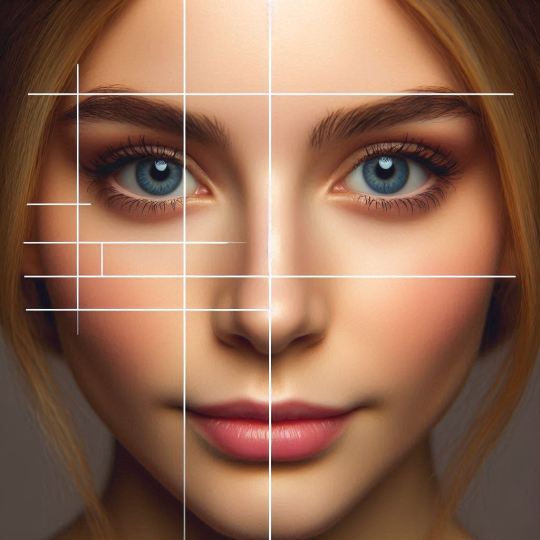
1. Rule of Thirds
The rule of thirds is one of the most well-known composition techniques. Imagine breaking an image down into thirds, both horizontally and vertically, so you have nine parts. Place your subject along these lines or at their intersections. This technique creates balance and interest in your photos.
2. Leading Lines
Leading lines guide the viewer’s eye through the photo. They can be roads, rivers, fences, or any other lines that lead towards the subject. These lines add depth and make your images more dynamic.
3. Framing
Framing involves using elements within a scene to create a frame around your subject. This could be anything from a window or arch to branches or a doorway. Framing adds context and draws attention to the subject.
4. Symmetry and Patterns
Symmetry and patterns appeal to the eye and create harmony. Look for natural or man-made patterns, and use symmetry to create a sense of order in your photos. This can be especially effective in architectural photography.
5. Perspective
Changing your perspective can transform a photo. Don’t be afraid to get low to the ground or find a high vantage point. Unique angles can add interest and show subjects in a new light.
6. Depth
Adding depth makes your photos feel more three-dimensional. You can achieve this by including elements in the foreground, middle ground, and background. This layering effect draws the viewer in and makes the image more engaging.
7. Negative Space
Negative space is the empty space around your subject. It helps to simplify the photo and emphasize the subject. Using negative space effectively can create powerful minimalist images.
8. Contrast and Color
Contrast and color play a crucial role in composition. High contrast can make your subject stand out, while complementary colors can create visual harmony. Experiment with different color schemes to see what works best for your subject.
9. Experimentation
Finally, don’t be afraid to break the rules. Photography is an art form, and some of the most striking images come from experimentation. Trust your instincts and try new techniques to develop your unique style.
By mastering these composition techniques, you can create visually stunning photos that capture the viewer's attention and tell a story. Happy shooting!
my website Valokuvaaja Lappeenranta. Valokuvauspalvelu Kuvaajankulma
0 notes
Text
The Role of Framing and Composition in Video Production: A Guide for Beginners
Introduction:
Framing and composition are key elements of visual storytelling. They help guide the viewer's eye, create meaning, and influence how the subject is perceived.
Basic principles of framing and composition, and their importance for video production.
The Rule of Thirds:
What Is the Rule of Thirds?: Breaking the frame into a grid of nine equal parts and placing key elements along these lines or at their intersections.
Why It Works: Creating balance in your shots and avoiding placing subjects too close to the edges of the frame.
Lead Room and Look Space:
Lead Room: When shooting moving subjects, it’s important to leave extra space in the direction of movement to allow the subject room to "move into."
Look Space: When framing a subject looking off-camera, leave space in the direction they are looking to create a balanced and natural composition.
Headroom and Avoiding Cutting Off Parts of the Subject:
Headroom: The space above a subject’s head. Too much headroom can make the shot look disconnected, while too little can make the subject feel cramped.
Framing the Subject: The importance of framing the subject so that they have enough space and are not cut off awkwardly.
The Use of Leading Lines:
Natural Leading Lines: Using elements like roads, hallways, or fences to lead the viewer’s eye to the subject or the focal point of the shot.
Purpose of Leading Lines: They can create depth, direct attention, and make the composition more engaging and visually dynamic.
Balancing Positive and Negative Space:
Positive Space: The area occupied by the subject(s).
Negative Space: The empty space around the subject. Both positive and negative space need to be balanced to create a harmonious shot.
When to Use More Negative Space: To convey isolation, loneliness, or tension.
Symmetry and Asymmetry in Composition:
Symmetry: Creating visually pleasing, balanced shots by positioning subjects centrally or in relation to each other symmetrically.
Asymmetry: Purposefully placing elements off-center to create visual interest or tension.
Depth and Perspective:
Creating Depth: Using foreground, middle ground, and background elements to create a sense of depth in your shot. Layering the scene adds realism.
Leading the Eye: Positioning objects in the foreground and background that naturally guide the viewer’s eye toward the main subject.
Practical Tips for Beginners:
Experiment with Framing: Don’t be afraid to play with different angles and perspectives to see what works best for your story.
Use a Tripod or Stabilizer: To ensure clean, stable shots and maintain proper composition.
Shoot in Manual Mode: Control settings like focus, aperture, and exposure to achieve better results.
Conclusion:
Mastering framing and composition takes practice, but it’s essential for creating visually captivating videos. By understanding and applying basic principles, beginners can significantly enhance the quality of their video production, even with limited equipment.
0 notes

